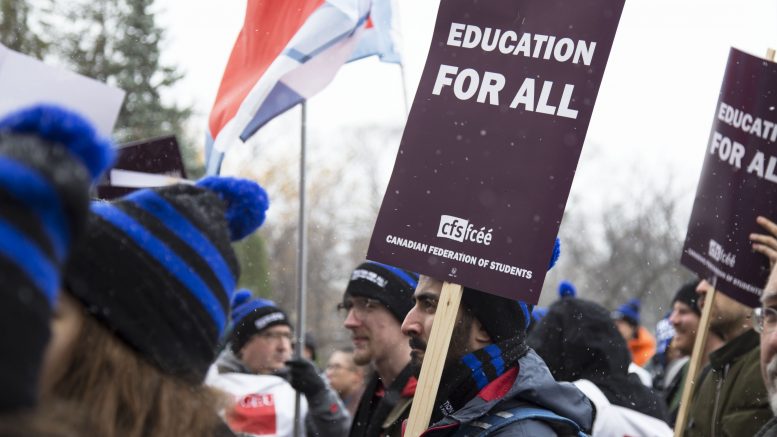In Winnipeg’s downtown core the poor, sick and homeless are selling their prescription medications to pay for the necessities of life. A CBC investigation reports the trade in meds has flourished in the area around Winnipeg’s homeless shelters. Meanwhile, poverty rates in Manitoba have skyrocketed, with an 83 per cent jump in food bank use by those on Employment Insurance and waitlists for public housing well beyond available capacity.
As a former inner-city activist, Premier Greg Selinger is well aware of the problems faced by low-income Manitobans. He knows that one in five children in Winnipeg live below the poverty line. He knows that Aboriginal poverty sits at 29 per cent. He also knows we have the resources to radically reduce poverty.
Ontario, Nova Scotia, Quebec and Newfoundland have all passed anti-poverty legislation that implements changes and sets measurable and achievable goals. In spite of its social democratic roots, the NDP’s “All Aboard” anti-poverty plan, released last spring, does not include a comprehensive poverty-reduction plan, hard targets, timelines or indicators of success. “I’m completely fine with having a separate piece of legislation for poverty reduction,” Selinger said during the NDP leadership race. With 125,000 Manitobans living in poverty and 56 per cent of Aboriginal children under six living in poverty, the time has come for the province to adopt a concrete poverty alleviation strategy. It’s up to all of us to hold the premier to his word.
Provincial unemployment now stands at 5.2 per cent (Aboriginal unemployment is nearly triple this at 15.4 per cent) with more layoffs and labour concessions on the horizon. Poverty has condemned thousands of Manitobans to a sustained state of crisis, made worse by the current economic downturn. Despite the new minimum wage of $9, when adjusted for inflation, wages have fallen relatively steadily since 1970. A single parent with one child now has to work 49 hours a week to just reach the poverty line, according to a report by the Canadian Centre for Policy Alternatives. Since 2004, Quebec has invested $3.3 billion in poverty reduction, including increasing the minimum wage, upgrading public housing, a work premium for low-income earners and an Employment Pact aimed at integrating youth into the labour market. These measures have resulted in a 14.2 per cent drop in the number of families receiving last-resort financial assistance. A sustained fight against poverty is about more than helping those in need. It’s about building a just society.
Thankfully, Manitobans overwhelmingly support such an initiative. Eighty per cent of Manitobans want the provincial government to implement a strategy to reduce poverty by 25 per cent over the next five years, according to a Canadian Centre for Policy Alternatives commissioned poll. A goal-oriented, sustained fight against poverty is about more than extending a helping hand. Despite the rhetoric of economic recovery, Canada’s GDP growth rate is on the decline at -3.23 per cent. Manitobans are not immune to this economic turbulence, which is why an increase in the minimum wage, more and better social housing, universal childcare access and more funds and lower fees for education and training will help strengthen our local economy.
Study after study links poverty to poorer health, higher incarceration rates and more demand on social and community services. For many young people, education is a way out of this cycle of poverty. From kindergarten to post-secondary, well-funded, public education is essential in combating poverty. Manitoba’s child care system desperately needs more funding, lower user fees, and an injection of capital. Following Ontario’s example of expanding full-day learning to 4-5 year-olds, for example, could make a huge difference for low- and middle-income families.
Average student debt in Manitoba sits around $19,000. Despite this, tuition fees rose by 4.3 per cent this year, the second-highest fee increase in the country. The largest barrier facing prospective post-secondary students (especially those from low-income families) is cost: keeping student debt low and continuing to support Aboriginal and low-income students will help build pathways out of poverty and debt for thousands of Manitobans.
As finance minister, Greg Selinger presided over tax cuts for businesses and high-income earners that have deprived the province of more than $1 billion in revenue that could be used to improve public housing, childcare and employment insurance, to properly fund schools and universities and to implement liveable wage legislation. The Canadian Centre for Policy Alternatives reports that the income levels of poor Manitobans could be brought up to the poverty line for a cost of under $516 million a year (or just 1.1 per cent of Manitoba’s annual GDP). Tax cuts for the wealthy have hurt low-income Manitobans, and done nothing to address the decay of social services, low incomes, and fragile employment numbers.
The Canadian Federation of Students, in conjunction with Make Poverty History Manitoba, calls on the province to take concrete action to cut poverty rates by 25 per cent over the next five years. Our Target Poverty campaign is aimed at mobilising and educating all Manitobans on the dire problems caused by poverty, and some of the solutions that are within reach.
If you’d like more information on the campaign, visit our website at targetpoverty.ca . Come voice your support for the campaign on Thursday, November 5 — rally on campus at 11:30 a.m., rally at the Legislature at 1 p.m..
Jonny Sopotiuk is the Chairperson of the Target Poverty Campaign, and Chris Webb is a publishing assistant at Canadian Dimension.




